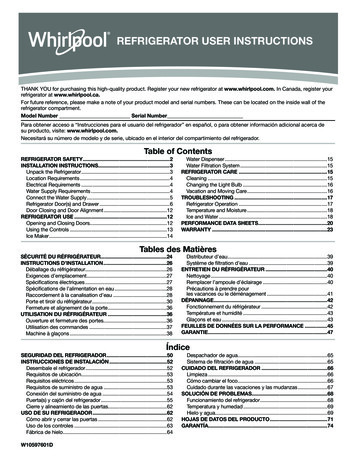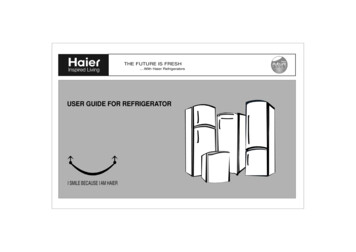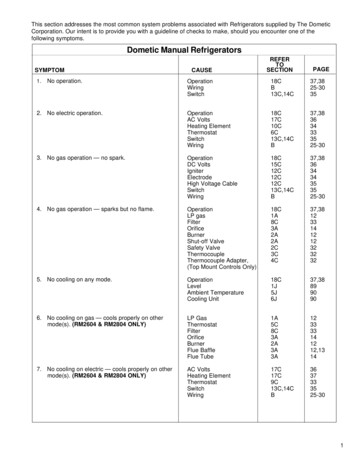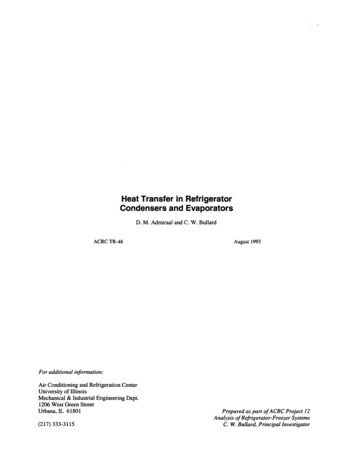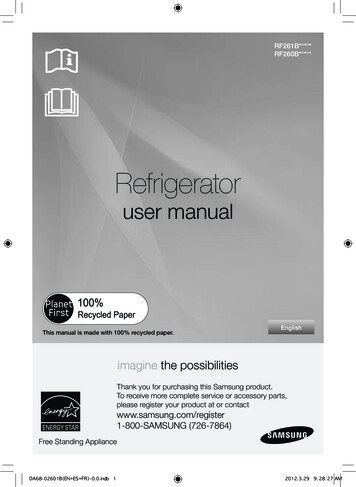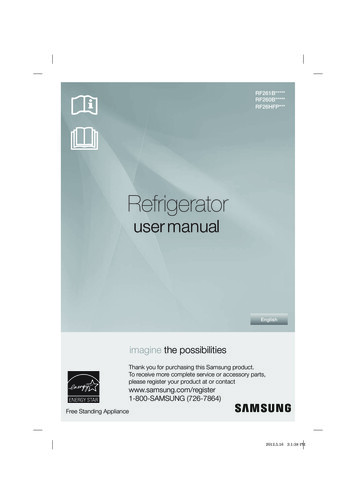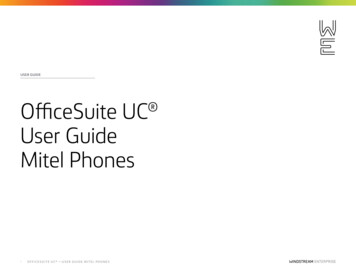
Transcription
User ManualEN Refrigerator - FreezerBedienungsanleitungDE Kühlschrank Mit TiefkühlfachGuide D’utilisationFR Réfrigérateur - CongélateurHandleidingNL Koelkast - VriezerREFRIGERATORUserManualManual de usoES Frigorífico - CongeladorManual de InstruçõesPT Frigorífico - CongeladorBrugsanvisningDK Køle - FryseskabSJ-T1227M4W-EUBruksanvisningNO Kjøleskap med FryserInstruktionsbokSE Kyl och EE Külmik - SügavkülmikLietošanas PamācībaLV Ledusskapis - SaldētājkameraLTNaudojimo InstrukcijaŠaldytuvas - Šaldikliswww.sharphomeappliances.com
ContentsCHAPTER -1: GENERAL WARNINGS.2CHAPTER -2: YOUR FRIDGE FREEZER.5CHAPTER -3: USING YOUR FRIDGE FREEZER.5CHAPTER -4: FOOD STORAGE GUIDANCE.7CHAPTER -5: DOOR REVERSAL.8CHAPTER -6: TROUBLESHOOTING.8CHAPTER -7: TIPS FOR SAVING ENERGY.9Your fridge freezer conforms to current safety requirements. Inappropriate use can lead to personal injury and damageto property. To avoid the risk of damage read this manual carefully before using your fridge freezer for the first time. Itcontains important safety information on the installation, safety, use and maintenance of your Fridge Freezer. Retainthis manual for future use.EN -1-
CHAPTER -1: GENERAL WARNINGS*****WARNING: Keep the ventilation openings of the FridgeFreezer clear from obstruction.WARNING: Do not use mechanical devices or other meansto accelerate the defrosting process.WARNING: Do not use other electrical appliances insidethe Fridge FreezerWARNING: Do not damage the refrigerant circuit.WARNING: To avoid personal injury or damage thisappliance must be installed in accordance with themanufacturer instructions.The small quantity of refrigerant used in this fridge freezeris eco- friendly R600a (an isobutene) and is flammable andexplosive if ignited in enclosed conditions.While carrying and positioning the fridge, do not damagethe cooler gas circuit.Do not store any containers with flammable materials, suchas spray cans or fire extinguisher refill cartridges in thevicinity of the fridge freezer.This appliance is intended to be used in household andsimilar applications such as;-- staff kitchen areas in shops, offices and other workingenvironments-- farm houses and by clients in hotels, motels and otherresidential type environments-- bed and breakfast type environments;-- catering and similar non-retail applicationsYour fridge freezer requires a 220-240V, 50Hz mains supply.Do not use any other supply. Before connecting yourfridge freezer, ensure that the information on the data plate(voltage and connected load) matches the mains electricitysupply. If in doubt, consult a qualified electrician)This appliance can be used by children aged from 8 yearsand above and persons with reduced physical, sensory ormental capabilities or lack of experience and knowledge ifthey have been given supervision or instruction concerninguse of the appliance in a safe way and understand theEN -2-
CHAPTER -1: GENERAL WARNINGShazard involved. Children shall not play with the appliance.Cleaning and user maintenance, shall not be made bychildren without supervision.* A damaged power cord /plug can cause fire or give youan electric shock. When damaged it must be replaced, thisshould only be done by qualified personnel.EN -3-
CHAPTER -1: GENERAL WARNINGSDisposal All packaging and materials used are environmentally friendly and recyclable. Please dispose of any packagingin an environmentally friendly manner. Consult your local council for further details. When the appliance is to be scrapped, cut off the electrical supply cable and destroy the plug and cable. Disablethe door catch in order to prevent children becoming trapped inside. A cut off plug inserted into a 16 amp socket is a serious safety (shock) hazard. Please ensure the cut off plugis disposed of safely.Disposal of your old applianceThis symbol on the product or package implies that the product should not be treated as domestic waste.Instead, it should be delivered to applicable waste collection places recycling electrical and electronicequipment. Recycling materials will help natural resources be preserved. For more detailed informationregarding recycling of this product, please contact local authority, domestic waste disposal service or theshop you have purchased the product from.Please ask your local authority about the disposal of the WEEE for the reuse, recycle and recoverypurposes.Notes: Please read the instruction manual carefully before installing and using your appliance. We are not responsiblefor the damage occurred due to misuse. Follow all instructions on your appliance and instruction manual, and keep this manual in a safe place to resolvethe problems that may occur in the future. This appliance is produced to be used in homes and it can only be used in domestic environments and for thespecified purposes. It is not suitable for commercial or common use. Such use will cause the guarantee of theappliance to be cancelled and our company will not be responsible for the losses to be occurred. This appliance is produced to be used in houses and it is only suitable for cooling / storing foods. It is notsuitable for commercial or common use and/or for storing substances except for food. Our company is notresponsible for the losses to be occurred in the contrary case.Safety warnings Do not connect your Fridge Freezer to the mains electricity supply using an extension lead. A damaged power cord / plug can cause fire or give you and electric shock. When damaged it must bereplaced, this should only be dine by qualified personnel.Never bend the power cord excessively.Never touch the power cord / plug with wet hands as this could cause a short circuit electric shock.Do not place glass bottles or beverage cans in the freezer department. Bottles or cans may explode.When taking ice made in the freezer department, do not touch it, ice may cause ice burns and/or cuts.Do not remove items from the freezer if your hands are damp or wet. Tis could cause skin abrasions or frost /freezer burns.Do not refreeze food once it has thawed out.Installation InformationBefore unpacking and manoeuvering your fridge freezer please take some time to familiarise yourself with the followingpoints. Position away from direct sunlight and away from any heat source such as a radiator. Your appliance should be at least 50 cm away from stoves, Gas ovens and heater cores, and should be at least5 cm away from electrical ovens. Do not expose your fridge freezer to moisture or rain. Your fridge freezer should be positioned at least 20mm away from another freezer. Clearance of at least 150 mm is required at the top and back of your fridge freezer. Do not place anything ontop of your fridge freezer. For safe operation it is important that your fridge freezer is safe and balanced. The adjustable feet are used tolevel your fridge freezer. Make sure that your appliance is level before placing any foodstuffsinside it. We recommend that you wipe all shelving and trays with a cloth soaked in warm water mixedwith a teaspoon of bicarbonate of soda before use. After cleaning rinse with warm water anddry. Install using the plastic distance guides, which can be found at the rear of the appliance. Turn90 degrees (as shown in the diagram). This will keep the condenser from touching the wall. Refrigerator should be placed against a wall with a free distance not exceeding 75 mm.Before Using your Fridge Before setting up your fridge freezer, check for any visible damage. Do not install or use your fridgefreezer if it is damaged When using your fridge freezer for the first time, keep it in an upright position for at least 3 hours beforeplugging into the mains. This will allow efficient operation and prevents damage to the compressor. You may notice a light odour when using your fridge freezer for the first time. This is perfectly normal andwill fade away as the fridge starts to cool.EN -4-
CHAPTER -2: YOUR FRIDGE FREEZER10111AB1292A) Freezer compartmentB) Refrigerator compartment8345761) Freezer shelf2) Thermostat box3) Fridge shelves4) Crisper cover5) Crisper6) Levelling feet7) Bottle shelf8) Door shelves9) Door shelf cover10) Ice tray11) Plastic ice blade12) Egg holderThis figure has been drawn for information purposes to show the various parts and accessories in the appliance.Parts may vary according to the model of the appliance.CHAPTER -3: USING YOUR FRIDGE FREEZERThermostat settingThe thermostat automatically regulates the temperatureinside the fridge and freezer compartments. To change thetemperature the knob can be rotated from position 1 to 5 (5being the coldest).Important note: Do not rotate beyond position 1 as this willstop your appliance working. For short-term storage of food in the freezer compartment,you can set the knob between 1 and 3 position. For long-term storage of food in the freezer compartment, you can set the knop to the 3-4 position.Note that; the ambient temperature, temperature of the freshly stored food and how often the door is opened, affectsthe temperature in the refrigerator compartment. If required, change the temperature setting.Warnings for temperature settings The ambient temperature, temperature of the freshly stored food and how often the door is opened, affects thetemperature in the refrigerator compartment. If required,change the temperature setting. It is not recommended that you operate your fridge in environments colder than 10 C . The thermostat setting should be set by taking into consideration how often the fresh food and freezer doorsare opened and closed, how much food is stored in the refrigerator and the environment in which and thepositioning of the appliance. We recommend that when first using the fridge freezer it should be left running for 24 hours uninterrupted toensure it is completely cooled . Do not open the fridge doors, or put food inside for this period. Your fridge freezer has a 5 minute built in delay function, designed to prevent damage to the compressor.When power is applied to your fridge freezer, it will beginClimate ClassAmbient Temperature oCto operate normally after 5 minutes. Your fridge is designed to operate in the ambientTBetween 16 and 43 ( C)temperature intervals stated in the standards, accordingto the climate class stated in the information label. It isSTBetween 16 and 38 ( C)not recommended that your fridge is operated in theNBetween 16 and 32 ( C)environments which are out of the stated temperatureintervals in terms of cooling efficiency.SNBetween 10 and 32 ( C)EN -5-
CHAPTER -3: USING YOUR FRIDGE FREEZERTemperature indicatorIn order to help you better set your refrigerator, we have equipped it with a temperature indicator located inthe coldest area.To better store the food in your refrigerator, especially in the coldest area, make sure the message “OK”appears on the temperature indicator. If « OK » does not appear, this means temperature has not been setproperlyOKIt may be difficult to see the indicator, make sure it is properly lit.Each time the temperature setting device ischanged, wait for the stabilisation of the temperature inside the appliance before proceeding, if necessary,with a new temperature setting. Please change the position of the temperature setting device progressively and wait atleast 12 hours before starting a new check and potential change.NOTE: Following repeated openings (or prolonged opening) of the door or after putting fresh food into the appliance,it is normal for the indication “OK” not to appear in the temperature setting indicator. If there is an abnormal build upof ice crystals of ice crystals (bottom wall of the appliance) on the refrigerator compartment, evaporator (overloadedappliance, high room temperature, frequent door openings), put the temperature setting device on a lower position untilcompressor off periods are obtained again.Store food in the coldest area of the refrigerator.Your foods will be better stored if you put them in the most appropriate cooling area. The coldest area is just abovethe crisper.The following symbol indicates the coldest area of your refrigerator.To be sure to have a low temperature in this area, make sure the shelf islocated at the level of this symbol, as shown in the illustration.The upper limit of the coldest area is indicated by the lower side of thesticker (head of the arrow). The coldest area upper shelf must be at the same level withthe arrow head. The coldest area is below this level.As these shelves are removable, make sure they are always at the same level with thesezone limits described on the stickers, in order to guarantee temperatures in this area.AccessoriesIce tray Fill the ice tray with water and place in freezer compartment. After the water completely turned into ice, you can twist the tray as shown below to get the ice cube.Visual and text descriptions on the accessories section may vary according which model you have.Cleaning Before cleaning your fridge freezer, turn your mains supply off and remove the plug from the socket.Do not wash your fridge freezer by pouring water on to it.Use a warm, soapy cloth or sponge to wipe the interior and exterior of your fridge freezer.Carefully remove all shelves and drawers by sliding upwards or outwards and clean with soapy water. Do notwash in a washing machine or dishwasher. Do not use solvents, abrasive cleaners, glass cleaners or all purpose cleaning agents to clean your fridgefreezer. This may cause damage to the plastic surfaces and other components with the chemicals they contain. Clean the condenser at the back of your fridge freezer at least once a year with a soft brush or vacuum cleaner.Make sure that your fridge is unplugged while cleaning.EN -6-
CHAPTER -3: USING YOUR FRIDGE FREEZERDefrostingRefrigerator compartment; Defrosting occurs automatically in the refrigerator compartment during operation ; water is collected by theevaporating tray and evaporates automatically. The evaporating tray and the defrost water drain hole should be cleaned periodically to prevent the water fromcollecting on the bottom of the refrigerator.Freezer compartment;Frost, accumulated in the freezer compartment, should be removed periodically. (Use the plastic scraper provided.)The freezer compartment should be cleaned in the same way as the refrigerator at least twice a year.For this; The day before you defrost, set the thermostat dial to “5” position to freeze the foods completely. During defrosting, frozen foods should be wrapped in several layers of paper and kept in a cool place.The inevitable rise in temperature will shorten their storage life. Remember to use these foods within a relativelyshort period of time. Set thermostat knob to position “ ” or unplug the unit; leave the door open until completely defrosted. To accelerate the defrosting process one or more basins of warm water can be placed in the freezer compartment. Dry the inside of the unit carefully and set the thermostat knob to MAX position.Replacing the light bulbTo replace the bulb in freezer and fridge departments;1. Unplug your fridge.2. Remove the cover of the box from the claws using ascrewdriver.3. Replace with a bulb of maximum 15 Watts.4. Install the cover.5. Wait for 5 minutes before re-plugging and bring thethermostat to its original position.Replacing LED LightingIf your fridge freezer has LED lighting contact the Sharp help desk as this should be changed by authorized personnelonly.CHAPTER -4: FOOD STORAGE GUIDANCERefrigerator compartment To reduce frost build up never place liquids with unsealed containers in the fridge compartment.Allow warn or hot food to cool down before storing. This helps reduce power consumption.To avoid frost buildup ensure that nothing is stored touching the back wall.The coldest area of the refrigerator is at the bottom. We recommend to use this area to store food that will perisheasily, such as fish, ready meals, baked goods or dairy products. The warmest area is the top shelf of the door.We recommend you store butter or cheese here.Freezer compartment Use the freezer to store frozen foods for long periods of time and make ice cubes. To freeze fresh food - ensure that as much of the surface of food to be frozen is in contact with the coolingsurface. Do not put fresh food on either side of frozen food as it can thaw it. While freezing fresh foods(i.e meat,fish and mincemeat),divide into portion sizes. Once the unit has been defrosted replace the foods into freezer and remember to consume them in a shortperiod of time. Never place warm food in the freezer compartment.EN -7-
CHAPTER -4: FOOD STORAGE GUIDANCE The instructions shown on frozen food packages should always be followed carefully and if no information isprovided food should not be stored for more than 3 months from the purchased date. When buying frozen foods ensure that these have been frozen at suitable temperatures and that the packingis intact. Frozen foods should be transported in appropriate containers to maintain the quality of the food and should bestored in the freezer as soon as possible. If a package of frozen food shows signs of humidity and abnormal swelling it has been previously stored at anunsuitable temperature and that the contents have deteriorated. The storage life of frozen foods depends on the room temperature, thermostat setting, how often the door isopened, the type of food and the length of time required to transport the product from the shop to your home.Always follow the instructions printed on the package and never exceed the maximum storage life indicated.That; If you decide to open the freezer door again immediately after closing, it may be difficult to re-open. This is normaland after the freezer has reached an equilibrium condition the door will open easily.Important note: Frozen foods, when thawed, should be cooked just like fresh foods. If they are not cooked after being thawedthey must NEVER be re-frozen. The taste of some spices found in cooked dishes (anise, basilica, watercress, vinegar, assorted spices, ginger,garlic, onion, mustard, thyme, marjoram, black pepper, etc.) changes and they assume a strong taste when theyare stored for a long period. Therefore, only add a small amount of spice if planning to freeze, or the desiredspice should be added after the food has been thawed. The storage period of food is dependent on the oil used. The suitable oils are margarine, calf fat, olive oil andbutter and the unsuitable oils are peanut oil and pig fat. The food in liquid form should be frozen in plastic cups and the other food should be frozen in plastic folios orbags.CHAPTER -5: DOOR REVERSALRepositioning the door It depends on which fridge freezer you have as to whether it is possible the reverse the doors. It is not possible where handles are attached at the front of the appliance. If your model does not have handles it is possible to reverse the doors, but this needs to be completed byauthorised personnel. Please call Sharp service.CHAPTER -6: TROUBLESHOOTINGIf your fridge freezer is not operating as expected, there may be a simple solution.If your refrigerator is not working.Check that ; It is switched on at the mains , The thermostat setting is on “ ” position,If the different compartments of the fridge do not get cold enough:Check that ; You have not overloaded the appliance , The doors are closed perfectly , There is no dust on the condenser , There
fridge freezer, ensure that the information on the data plate (voltage and connected load) matches the mains electricity supply. If in doubt, consult a qualified electrician) * This appliance can be used by children aged from 8 years and above and persons with reduced physical, sensory or m

